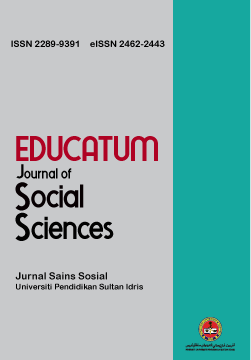Cultural Sharing Through Visual Art Exhibition ‘Dalam Bingkai’ by JSRB-UPSI with FSRD-ISBI
DOI:
https://doi.org/10.37134/ejoss.vol6.2.3.2020Keywords:
Artwork Making, Partnership, Art and Culture ExhibitionAbstract
The cultural sharing of artworks and the creation of visual art can be expressed through exhibitions and demonstrations of artistic involvement. The artistic exhibitions can facilitate the factors of appreciation and understanding of visual art culture. Through the field of visual arts program, artworks and creation was inspired by the Department of Art and Design, Faculty of Art, Computers and Creative Industry (FSKIK) in collaboration with the Faculty of Design and Design (FSRD), Indonesian Institute of Cultural Arts, Bandung (ISBI). The ‘Dalam Bingkai’ Visual Art Exhibition associates the influence of internal sensible factors on the construction of an artwork. Art and cultural contribution programs are generated to achieve the field-sharing approach and mechanism. The objectivity towards this article sharing is due to the knowledge of the artistic delivery in preferring the style and gaining the experiences based on the artwork requirements. The article addresses the inquiries related to the fundamental aspect of visual art and the extension of artistic fundamental practice demands. The article is also based on an exploration of the pragmatic factors of the artwork construction. The quality of the visuals art argument of reflection related to the quality of the artwork that opens up the success of the impact upon the acceptance and attention. The understanding of the cultural sharing can be associated with logical thinking and the perception of awareness in the artwork making. The concept of visual practice is related to the factors of observation that need to be defined through the perception of the artist. The methodology relates to the artwork collection in exhibition space that indicates the content in presenting at UPSI Art Gallery. The appointed exhibition curators express the visual description into the reality of the artwork making. The observation processes promote the data based such as from field notes, interviews, photos and video recordings. The understanding of the elements and principles of visual arts technically meant as guidance. The duration of the exhibition was four (4) days aimed at the impact of the subject of ‘Dalam Bingkai’ meaning. Visual art exhibitions and cultural programs through a collective of an artistic understanding contribute to the stress-free condition from the artist perspective.
Downloads
References
Bradfield, M. (2020). Ordinary extraordinary: the para/pata: institutionalism of Critical Practice. Journal of Visual Art Practice, 19:1, 38-52,
DOI: 10.1080/14702029.2020.1728049
Christensen, M. S. (2004). Introducing Excitability. In Proceedings of the Nordic CHI 2004 Workshop, October 24, 2004, Tampere, Finland, pp. 10-13.
Collins, C.C. (2019). On posthuman materiality: art-making as rhizomatic rehearsal. Text and Performance Quarterly, 39:2, 153-159,
DOI: 10.1080/10462937.2019.1595121
Cupchik, G. C. (1995). Emotion in Aesthetics: reactive and reflective models, Poetics, vol. 23, pp. 177-188.
Frank-Witt, P. (2020). Intentionality in art: empirical exposure. Journal of Visual Art Practice,
DOI: 10.1080/14702029.2020.1752514
Froggett, L., Muller, L., & Bennett, J. (2019). The work of the audience: visual matrix methodology in museums. Cultural Trends, 28:2-3, 162-176,
DOI: 10.1080/09548963.2019.1617939
Frost, S. (2019). A Complex Art of Logistics. Visual Culture in Britain, 20:1, 15-39,
DOI: 10.1080/14714787.2019.1576538
Gibson, J. J. (1979). The Ecological Approach To Visual Perception. Houghton Mifflin, Boston.
Kenning, D. (2019). Art world strategies: neoliberalism and the politics of professional practice in fine art education. Journal of Visual Art Practice, 18:2, 115-131,
DOI: 10.1080/14702029.2018.1500112
Lauwrens, J. (2019). Touch as an aesthetic experience. Journal of Visual Art Practice, 18:4, 323-341,
DOI: 10.1080/14702029.2019.1680510
Merleau-Ponty, M. (1962). Phenomenology of Perception. Routledge & Kegan Paul, London.
Musa, R., Ramli, M., Mohd Khairuddin, N., & Abindinhazir, Z. (2019). Eksplorasi lakaran bertema kenderaan serta kesan terhadap kreativiti kanak-kanak. KUPAS SENI: Jurnal Seni Dan Pendidikan Seni, 7, 72-80. Retrieved from
http://ejournal.upsi.edu.my/index.php/JSPS/article/view/2708
Nagamachi, M. (2002). Kansei Engineering As A Powerful Consumer-Oriented Technology For Product Development. Applied Ergonomics, vol. 33, no. 3, pp. 289-294.
Oman, S., & Taylor, M. (2018). Subjective well-being in cultural advocacy: a politics of research between the market and the academy. Journal of Cultural Economy, 11:3, 225-243,
DOI: 10.1080/17530350.2018.1435422
Porr, M. (2019). Rock art as art. Time and Mind, 12:2, 153-164,
DOI: 10.1080/1751696X.2019.1609799
Ramli, M. F. (2019). Argumentasi Terhadap Pergerakan Fesyen Jalanan Tempatan. KUPAS SENI: Jurnal Seni Dan Pendidikan Seni, 6. Retrieved from
http://ejournal.upsi.edu.my/index.php/JSPS/article/view/2278
Ramli, M. F., & Musa, R. (2020). Ekplorasi seni visual melalui aktiviti lakaran asas terhadap kanak-kanak prasekolah. Jurnal Pendidikan Awal Kanak-Kanak Kebangsaan, 9, 35-47. Retrieved from
http://ejournal.upsi.edu.my/index.php/JPAK/article/view/3712
Rowe, C. (2020). The degree show may not be your best show. Journal of Visual Art Practice, 19:1, 53-68,
DOI: 10.1080/14702029.2020.1724664
Salem, B., Nakatsu, R., & Rauterberg, M. (2006). Kansei Experience. Aesthetic, Emotions, And Inner Balance.
Wong, S.K.S. (2019). Applying an ethological perspective of art to the community arts and socially engaged arts. Journal of Visual Art Practice, 18:3, 205-220,
DOI: 10.1080/14702029.2019.1613614





